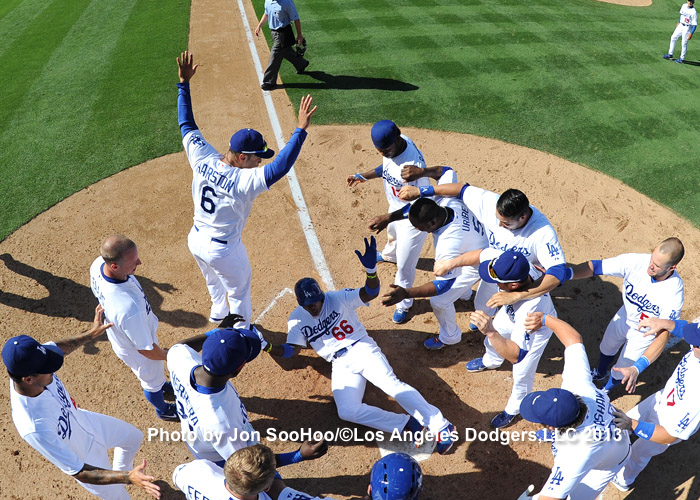If there is one baseball statistic that every MLB hitting coach hates more than any other it has to be leaving runners on base (LOB). Regardless of how a team gets runners on base, stranding them there is usually the kiss of death. In its simplest form, LOB = Loss.

There are few things more frustrating than striking out to end an inning with runners left on base, as Matt Kemp did on Opening Day 2013. (Photo credit – Ron Cervenka)
Having been a Dodger fan since before the team moved to Los Angeles from Brooklyn in 1958, I can tell you that there hasn’t been a single season where the Bums haven’t led all of baseball in LOB. Okay, that’s an exaggeration, but it sure seems that way, doesn’t it? But the truth of the matter is that this isn’t all that far from actually being the truth of the matter. Let’s use… say, 2013 for example:
In 2013 the Dodgers won the NL West title by a rather comfortable 11-game margin over the Diamondbacks. So what’s the big deal about LOB? The big deal is that had it not been for their historic 42-8 run from June 22 through August 18, the Dodgers could have just as easily lost the NL West title by 11 games. The Dodgers were 26th (out of 30 MLB teams) in LOB with a mind-boggling 14.94 LOB average per game in 2013. To compound matters, the Dodgers were 22nd in all of baseball in 2013 in leaving runners in scoring position (RISP) with 3.62 per game. Ironically, the eventual World Series Champion Boston Red Sox were 29th in LOB at 15.74 and dead last in RISP with 3.89. This speaks volumes as to just how great the 2013 Red Sox really were – with or without runners on base.
The point to all of this is that when you have a powerful offense that scores a lot of runs regardless of LOBs, it isn’t that big of a deal, but when you are involved in a lot of close games, as the Dodgers seem to always be, leaving men on base and especially in scoring position is a killer.
During the early part of the 2013 season, the Dodgers were plagued with injuries that found them in last place and 9.5 games back in the NL West on June 21 – due in large part to an exceptionally high number of men left on base. In other words, the Dodgers were ‘getting ’em on’ but weren’t ‘getting ’em in.’ To his credit, Dodger manager Don Mattingly maintained his cool, this in spite of being on the national media hot seat with many writers expecting him to be fired. Mattingly told reports one day before game in mid-May “We’re getting a lot of traffic out there [on the bases], it’s just a matter of time before we start scoring them.” And while this is exactly what happened once Cuban superstar Yasiel Puig was called up on June 3 and a healthy Hanley Ramirez returned to the line-up the next day, you can pretty much bet that Mattingly was sweating bullets until the miracle run began almost three weeks later.

There are few things greater than leaving no one on base, as Yasiel Puig did with his epic ‘slide-off’ grand slam on July 28, 2013 . (Photo credit – Jon SooHoo)
With the Dodgers potentially having one of the most powerful offensive line-ups in all of baseball, they are expected to score a lot of runs in 2014. But to accomplish this, they have got to first get runners on base and then drive them in. It does no good to get them on base and leave them there regardless of how powerful their line-up is. Over the course of a season, more runs will be driven in by consecutive base hits (even singles) than by a bunch of solo home runs.
So what does a hitting coach do to get his guys to reduce the number of LOBs? Actually he can do nothing more than suggest to his hitters to approach every at bat as the game dictates – it’s up to each individual hitter to accept this advice or not. With one out or less and a runner on first base, there is nothing wrong with guys like Adrian Gonzalez, Yasiel Puig, Andre Ethier, Hanley Ramirez or even Dee Gordon for that matter taking a first-pitch hack for the fence. But when they get down to two strikes, they might want to consider shortening up their swing a bit and try for a base hit instead. Granted, everybody loves the long ball but there are times (actually more frequently than not) where three or four consecutive base hits will do more damage than a home run. If nothing else, they will increase the pitch count of the opposing pitcher and get them out of the game a lot faster.
No one can dispute that Mark McGwire and John Valintin have done and outstanding job with Dodger hitters, but until these hitters begin to show the type of at bats and plate discipline that the Cardinals and a couple of other teams are famous for, they will probably continue to led the majors every year in LOB and RISP. The 2014 season is as good a time as any to turn this dubious Dodgers tradition around, wouldn’t you say?




 March 21st, 2014 at 6:00 am
March 21st, 2014 at 6:00 am  by Ron Cervenka
by Ron Cervenka  Posted in
Posted in 

I have to agree it is getting to be like a tradition. They went on that 42-8 spree by leaving less men on base especially with runners in scoring position, which really hurts the most.
It goes without saying, if they can avoid leaving so many men on base they’ll almost duplicate last years record run.
Offense has mostly hurt this team as the pitching has mostly been it’s strongest suit.
Good article, Ron.
It is frustrating with the big hitters in the lineup. In the NL the Dodgers in 2013 were third in BA, third in OBP and fourth in hits.
Yet only the Giants (14.98) in the NL left more runners/game on base than the Dodgers (14.94). Guess who led the pack in MLB? Houston (13.10) – huh.